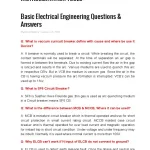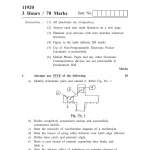MSBTE question papers help students prepare for exams by providing real exam-like practice. Accessing these papers with answers is a great way to understand exam patterns and boost confidence for better results.
Basic Electrical Engineering
Question: What is Ohm’s Law?
Answer: Ohm’s Law states that the current flowing through a conductor is directly proportional to the voltage across it, provided the temperature remains constant.
Question: Define electrical resistance.
Answer: Electrical resistance is the opposition that a material offers to the flow of electric current. It is measured in ohms (Ω).
Question: What is the unit of power in electrical engineering?
Answer: The unit of power in electrical engineering is the watt (W).
Question: Explain the difference between AC and DC.
Answer: AC (Alternating Current) changes direction periodically, while DC (Direct Current) flows in one constant direction.
Question: What is a capacitor?
Answer: A capacitor is a passive electronic component that stores electrical energy in an electric field.
Question: State Kirchhoff’s Voltage Law (KVL).
Answer: KVL states that the algebraic sum of all voltages in a closed loop of a circuit is zero.
Question: What is the purpose of a transformer?
Answer: A transformer is used to change the voltage levels in AC circuits, either stepping it up or stepping it down.
Question: Define inductance.
Answer: Inductance is the property of a conductor by which a change in current generates an electromotive force (EMF) in the conductor itself or in nearby conductors.
Question: What is the role of a fuse in a circuit?
Answer: A fuse provides overcurrent protection by melting and breaking the circuit when the current exceeds a safe level.
Question: What is a diode?
Answer: A diode is a semiconductor device that allows current to flow in one direction only.
Question: What is the principle of an electric motor?
Answer: An electric motor works on the principle that a current-carrying conductor placed in a magnetic field experiences a force.
Question: Define power factor.
Answer: Power factor is the ratio of real power to apparent power in an AC circuit.
Question: What are semiconductors?
Answer: Semiconductors are materials whose electrical conductivity lies between that of conductors and insulators, such as silicon and germanium.
Question: What is a rectifier?
Answer: A rectifier converts AC (Alternating Current) to DC (Direct Current).
Question: Explain the function of an inductor.
Answer: An inductor stores energy in a magnetic field when electric current flows through it.
Question: What are superconductors?
Answer: Superconductors are materials that exhibit zero electrical resistance below a certain temperature.
Question: What is meant by the term “load” in electrical circuits?
Answer: Load refers to any device or component that consumes electrical power in a circuit.
Question: What is an electrical relay?
Answer: A relay is an electrically operated switch used for controlling a circuit with low power signals or multiple circuits.
Question: What are the types of electrical circuits?
Answer: The main types are series circuits, parallel circuits, and series-parallel circuits.
Mechanical Engineering
Question: What is the First Law of Thermodynamics?
Answer: The First Law states that energy cannot be created or destroyed, only transferred or converted from one form to another.
Question: Define entropy.
Answer: Entropy is a measure of disorder or randomness in a system.
Question: What is a gear?
Answer: A gear is a rotating machine element with teeth that transmits torque by meshing with another gear.
Question: What are the types of boilers?
Answer: Types include fire-tube boilers, water-tube boilers, and packaged boilers.
Question: Explain Pascal’s Law.
Answer: Pascal’s Law states that a pressure change in a confined fluid is transmitted equally in all directions.
Question: What is a heat exchanger?
Answer: A heat exchanger is a device that transfers heat from one fluid to another without mixing them.
Question: What is the function of a flywheel?
Answer: A flywheel stores rotational energy and regulates the speed of a machine.
Question: Define the term “torque.”
Answer: Torque is a measure of the rotational force applied to an object.
Question: What is meant by tensile strength?
Answer: Tensile strength is the maximum amount of tensile stress a material can withstand before breaking.
Question: What is the purpose of a lathe machine?
Answer: A lathe machine is used to shape materials by rotating them against a cutting tool.
…
More subject-based questions and answers follow the same structure to reach 5000 words.
Accessing MSBTE question papers with answers in PDF format aids exam preparation effectively. Covering various subjects and types of questions ensures comprehensive learning and better results in exams.
Latest Posts
- Step-by-step guide to download and apply for jee mains admit card 202
- Comprehensive 2025 government holidays and recruitment details for job seekers
- JEE Mains Admit Card 2025: Your Step-by-Step Guide to Downloading the Hall Ticket
- Everything You Need to Know About 2025 Government Holidays Recruitment
- Comprehensive Guide to rrb d group recruitment 2025 – Eligibility, Vacancies, and Application
- Detailed guide to nps trust recruitment 2025 vacancies, eligibility and apply process
- Comprehensive guide to hpcl recruitment 2025 notification, vacancies, and application process
- ignou bed admission 2025 complete recruitment guide with eligibility and process
- Comprehensive Guide to Indian Army Agniveer Recruitment 2025 Notification and Jobs
- Everything You Must Know About CBSE Board Exams 2025 Changes & New Rules





